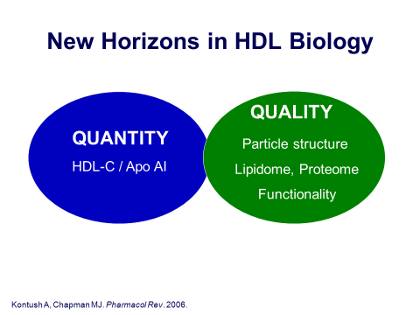Chapman - Figure 2 - Quantity vs Quality Text
We are at an exciting transition point in understanding the biology of high-density lipoprotein (HDL) cholesterol and its relevance to cardiovascular disease (CVD). For many years we have focused on measuring the “amount of HDL” in the circulation, and the parameter that we have measured has been the serum cholesterol transported in HDL particles or, in some cases, the main protein component of HDL particles, apolipoprotein A-I (apoA-I).
More recently, however, we have begun to realize that, although “HDL cholesterol” has proven extremely useful as a predictor of CVD risk in many different populations, unfortunately this does not really give us insights into what we have come to understand as the atheroprotective properties of the HDL biologic processes. What is meant by “the atheroprotective properties of HDL cholesterol”? HDL metabolism performs multiple functions that are highly relevant to protection of the arterial wall and to protection against development of atherosclerotic disease – which primarily involves accumulation of cholesterol from the circulation into the atherosclerotic plaques, of course.
As a result, the focus has moved from the quantity of “HDL cholesterol” in the blood to the quality of HDL particles, by which we mean the structure of the HDL particles, in a molecular sense, and to the nature of the building blocks that make up individual HDL particles.[1][2] The building blocks of the lipoprotein particles – which take up lipids such as cholesterol and circulate them throughout the body’s principally aqueous milieu – are lipids and proteins, and when we consider all the lipids that are accumulated within a particle we use the term the “lipidome,” and when we consider all of the proteins that principally form the particle structures encapsulating those lipids, we now use the term “proteome” – and these 2 terms will be the subject of this review.
At this advanced stage in our understanding of the body’s lipid metabolism, we have moved to a point where we believe that lipoprotein particle structure – ie, lipids plus proteins, as determined by the lipidome and the proteome – are absolutely critical features of what will ultimately be expressed as the “functionality” of the HDL particle. So that is what we mean by the quality of HDL.
J Clin Lipidol. 2011; 5(6).References
[1]Kontush A, Chapman MJ. Functionally defective high-density lipoprotein: a new therapeutic target at the crossroads of dyslipidemia, inflammation, and atherosclerosis. Pharmacol Rev. 2006 Sep;58(3):342-74.
[2]Kontush A, Chapman MJ. Antiatherogenic function of HDL particle subpopulations: focus on antioxidative activities. Curr Opin Lipidol (2010); 21: 312-318.
